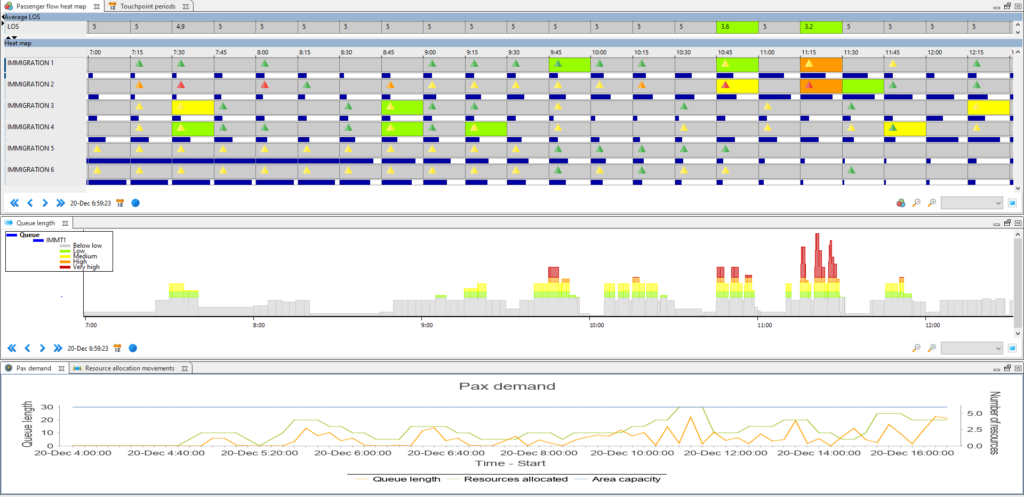As governments around the world start to ease lockdown measures and resume economic activities, airport operators are facing new challenges, two of them being density management and physical distancing. Airports must comply with new health policies introduced by respective regulators, keeping the airport terminals and buildings a safe environment for passengers as well as their own employees.
We at DTP are experts in airport operations as well as planning and optimization solutions. In the past weeks, we worked very closely with our global partners on analyzing these emerging business needs, and we’ve shaped our solutions to help our customers have a safe reopening and ensure a protected travel experience. Integration, a core element of DTP’s DNA, allows us to build a hybrid offering including the best of breed solutions and maximize the business values earned by our customers.
In our offering, we address the following questions:
- How can airports simulate and validate the changes required in the terminals due to COVID-19 in an efficient and cost-effective way?
- How can airports balance avoiding passenger crowds and maintaining high throughput?
- How can airports monitor in real time what is happening in passenger areas and predict disruptions before they happen?
- Is it worth the investment required?
The proposed solution can be summarized in the below functional diagram:

“The safety, security, and health of passengers and staff remain top priorities for airports and their partners in the aviation industry.”
Angela Gittens, Airports Council International (ACI) World
Model and Simulate
Dassault Systèmes (3DS) Virtual Twin is a digital replica of an airport as well as its assets, systems, and processes. It has been used for many years across different industries, like manufacturing, oil & gas, and retail, with huge benefits. It’s time for airports to consider the implementation of its own Virtual Twin across multiple functions like engineering services and terminal operations. This will enable airports to avoid disruptions and enhance the passenger experience while keeping them safe, healthy, and secure.
Using the 3DS Virtual Twin, airport teams can perform virtual testing to simulate the airflow within airport terminals, validate that it’s done in an effective way to minimize virus propagation, if it happens, and then highlight potential cross-infection areas as well as related impacts on the passengers and their surroundings. Several success stories are available from 3DS customers in the medical field, and DTP is working very closely with them to replicate the same in an airport environment.
In addition, airports can optimize their operational performance by running what-if scenarios based on simulation and/or real data in the virtual world without impacting day-to-day operations. This allows airports to model, simulate, and analyze the impact of changes introduced in the passenger areas due to COVID-19, such as physical distancing, changes in the layout of check-in areas, and redistribution of passport control queues, before investing in civil works. This will help airports identify the best possible configuration compliant with all the safety regulations and allow the fastest passengers’ throughput in an efficient and cost-effective way.
Plan and Optimize
Taking into consideration the current airports’ operational models, maintaining physical distancing between passengers will be a challenge. The immediate impact is reduced capacity of the airports’ facilities due to a lower number of people allowed in the same place at the same time. Queues in specific areas like check-in and security scanning will be redesigned, and new touch points like thermal scanning and medical tests may be introduced. As explained earlier, this work would be designed, simulated, and validated using the 3DS Virtual Twin. Hence, airport operators would need to decide between reducing its capacity or improving the management of passenger flow across its terminals.
Based on the above, airports are in need of solutions allowing them to model and optimize the passenger flow across all touchpoints, from terminal entrance to boarding the airplane, taking into consideration the modified number and configuration of lanes. The same shall be applied for arriving and transiting passengers and their respective processes. The ultimate goal is to have the best possible plan for each touchpoint to meet the target level of service, considering all interdependencies with other touchpoints. In other words, and in case the touchpoints plans are optimized in isolation, this may lead to passengers moving at top speed across one touch point but overcrowded in the following one.
DTP has developed a passenger flow modeling and optimization solution based on the 3DS DELMIA Quintiq optimization platform. The model helps airport operators to optimize the passenger journey across all terminals and buildings, taking into account multiple constraints like physical distancing, average processing time in each touchpoint, dynamic walking distance, and transportation mode (i.e. bus movements and intermodal trains). The solution allows the airport to identify the best possible plan for all touchpoints (e.g. number of security and passport control lanes to be opened) to optimize crowd management and meet the target level of service. The outcome is shared automatically by the respective stakeholders within the airport through real-time interfaces to do their own shift planning and task assignments.

This optimized plan will allow airports to ensure that passengers are served by the optimum number of airport services staff, thus eliminating the risks associated with overstaffing.
Monitor
Once the passenger flow plan is optimized using the DELMIA Quintiq platform and the respective stakeholders receive the demand and service expected from their side, the airport management needs to validate what’s happening in actual operations to ensure that the respective KPIs and level of service are met in reality. Hence, airports would need live situational awareness solutions that can monitor in real time the density in each area and ensure everything is being executed as per the plan. This is where the internet of things (IOT) and tracking sensors enter the picture.
DTP works closely with Xovis, a global leader in real-time crowd monitoring and flow measurements that’s trusted by over 70 international airports. Xovis 3D sensors and software modules allow airports to monitor the status of each touchpoint, such as which counters are open or closed, queue lengths, average waiting time, process time and passenger throughput. This allows airport authorities to monitor in real time the actual status versus the planned demand. Furthermore, the solution has been extended to monitor the distance between the passengers and confirm If physical distancing is being observed. This new feature could not be possible without the high accuracy of the Xovis sensors.
Furthermore, Xovis 3D sensors can be placed at specific locations, for instance in confined spaces like boarding lounges, in order to measure the density in real time and ensure compliance with the new regulations related to capacity filling levels.
Predict and Inform
Once the crowd monitoring solution is implemented, and the queues/physical distancing is being monitored in real time, the data needs to be presented to the airport management using a simple and clear common situational awareness platform. This platform should ensure that the right information is shared at the right time with the right stakeholder(s). Through artificial intelligence and forecasting models, the system would allow the airport to move from firefighting to a data-driven, proactive operational model. In other words, it should be able to analyze all the inputs received from the tracking and monitoring solutions and predict issues before they happen, so that airport management can take the required precautions.
The real-time data of the passenger flow monitoring solution can be shared as a feedback loop with DELMIA Quintiq flow optimization engine. The DELMIA Quintiq ‘propagator’ correlates the received data with the existing plans, analyzes the impact on downstream flows, and predicts potential bottlenecks. Through continuous or user controlled optimization, new plans are generated and shared with the respective stakeholders.
Additionally, DTP’s tNexus Airport View, a state-of-the-art mobile application used by multiple airports in the Middle East, can enable collaboration among stakeholders. Through aviation standard APIs, tNexus Airport View can receive data from multiple systems within the aviation ecosystem, including airports, airlines, ground handlers, and air navigation service providers. The application presents a single source of truth, ensuring that all required stakeholders have access to the right information at the right time to make the required decisions. One of the core components of Airport View is turnaround monitoring, allowing the airport management to track all the ACDM milestones of a full flight rotation. It also includes a business intelligence engine that predicts operational exceptions before they happen, like flight delays.
Some of the useful data sources for Airport View during these unprecedented times are passenger flow monitoring solutions and thermal cameras. Through built-in executive dashboards, inter-terminal maps, and automated, custom notifications, airport management can get automatically notified about COVID-19 specific alerts. Airport View can provide a holistic view of all the touchpoints’ status, allow users to compare it with the flow plan done using DELMIA Quintiq, and predict long queues or crowds before they happen. Other benefits of the mobile app include built-in issues reporting and direct messaging. For instance, airport staff can identify, report, and close high-risk areas where passengers with high temperatures are detected, and request other flights to be reallocated to other areas and redirect passenger flow.
Is it worth the investment?
While preparing for reopening, airport management around the globe are busy implementing new solutions like thermal cameras and baggage sanitation. However, according to Gartner, COVID-19 is a major disruption that will trigger digital transformation programs within organizations like nothing else before. Obviously, the same applies for the aviation industry. Airports need to differentiate themselves as a safe environment, and technology plays a crucial role in reaching such a goal.
To summarize, the above solutions represent a baseline for airports to simulate and analyze the required changes within their terminals in a fast, agile, and cost-effective way, thus enabling savings in terms of CAPEX; to serve more passengers using the optimum number of physical and human resources, thus enabling savings in terms of OPEX; and to predict disruptions and avoid them before they happen, thus preventing loss of revenue.
When the COVID-19 pandemic is over or a vaccine is found, and the passenger traffic is back to normal as before 2020, none of these solutions will be wasted. All these solutions can and do serve other functions within the airport ecosystem. They can optimize the airport operations by serving more passengers using the optimum number of resources, and help you ensure high levels of satisfaction for the passengers who are eager to travel again.

